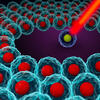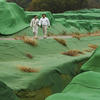You are here
Fukushima insects tested for cognition

Bees and hornets are known to have a wide range of cognitive skills, including the ability to recognise colours and navigate in space. However, pollution by substances released into the environment by humans, such as pesticides, can impair their performance.
Olivier Armant, from the radionuclide ecology and ecotoxicology laboratory at the French ASNR nuclear safety and radiation protection authority, and Mathieu Lihoreau, an ethologist from the Research Centre on Animal Cognition at the Centre for Integrative Biology1 wondered what effect ionising radiation might have on these pollinators. Armant works on the ecological impact of such radiation, carrying out long-term studies on the fauna and flora around Chernobyl (currently inaccessible, due to the war in Ukraine) and Fukushima, Japan, while Lihoreau focuses on bee intelligence and the factors that may interfere with it.
Assessing cognitive performance
"A few years ago, a researcher in my lab came up with the idea of deploying various types of sensor to monitor, preferably automatically, the biological activity of certain species in the aftermath of the Fukushima disaster," Armant explains. "We had three projects in mind: connected nest boxes, a system that measured the biotic parameters of water and – the one we chose – the method developed by Mathieu Lihoreau." 2 For several years, the ethologist has been working on an automated system to assess the cognitive performance of these social insects. The device they use was designed in partnership with the Toulouse-based start-up BeeGuard, which manufactures connected beehives that enable real-time monitoring.
"I study the learning and memory abilities of bees," Lihoreau explains. "Although this is primarily a fundamental research topic, it also has very concrete applications in ecotoxicology: if bees exhibit learning deficits in certain locations, it means there's a problem. For example, although many pesticides are used in doses that are low enough not to kill these insects, they end up as residues in the nectar they feed on and can have a neurotoxic effect. This results in cognitive disturbances that are difficult to observe, such as the inability to associate a reward with a specific colour or smell. Our system can measure these effects, which, although not lethal, are nonetheless serious, because they have a knock-on effect on the survival of colonies and, more generally, on pollination services."
When disturbed in this way, bees begin to forage on flowers of different species, instead of focusing on just one. As a result, they no longer bring the right pollen to the right plants, which affects the entire ecosystem. The device developed by Lihoreau's team (made up of biologists, engineers, modellers and ecologists) had until now only been tested near Toulouse (southwestern France), rather than in the extreme conditions of an area like Fukushima, which the scientists were able to enter with the help of their Japanese colleagues.
"We started collaborating with Japan just after the Fukushima disaster, in 2011," Armant explains. "We work in particular with Fukushima University's Institute of Environmental Radioactivity (IER), which help us to access the contaminated area. Our Japanese colleagues have extensive knowledge of the site and its forests, and they were able to direct us to the most interesting locations. This enabled us to carry out two field investigations in 2023 and 2024."
How do you go about testing bees?
The sites where the beehives were set up3 were selected on the basis of the soil contamination gradient for caesium-137. Local hornets, already present on the sites, were also included in the cognition study. Although it isn't clear whether these species are pollinators, they are worth studying, as they are descended from many generations of insects exposed to radiation.
But just how do you carry out cognitive tests on an insect? "The system is based on conventional experimental protocols developed in the laboratory over the past 50 years," Lihoreau says. It uses a Y-shaped maze, in which the insect can choose between two branches illuminated by coloured LEDs, either blue or yellow. The insect needs to understand that it will be rewarded with sugar water, dispensed by a pump at the end of the branch, only if it chooses the right colour (blue or yellow, depending on the tests).
A healthy bee needs 10 tests on average to find the correct path by following the right colours. "This figure enables us to establish learning curves, which can then be compared to see if there is an impact on their ability to solve the problem," Lihoreau adds.
Bees equipped with a QR Code
The protocol used at Fukushima is automated. Each bee is equipped with a 2-mm-wide QR Code which is read by a camera, activating the opening of the maze. This customisation makes it possible to test the learning process of each insect, whose behaviour is filmed, analysed and sent in real time to a server. The whole operation is powered by solar panels.
Giant hornets, which are too big to enter the system, were tested manually in more traditional mazes. "Our Japanese colleagues initially tried to dissuade us from handling them, because they are so dangerous," Lihoreau recalls. "However, the hornets are extremely useful for understanding the environmental impact of radioactive contamination, because these predators are at the top of the food chain and, unlike our honeybees, have always been present in the area, since well before the nuclear accident."
Although the results of the study have yet to be published, scientists are already reporting a decline in insect cognition in the contaminated area of Fukushima Prefecture. "We can see correlations," Armant says. "However, a causal link with radioactive contamination has not yet been established. But since the area is no longer inhabited, it is unlikely that the effect is due to factors such as pesticides." ♦
See also
Of bees and men
Learning from the Fukushima decontamination
- 1. CRCA-CBI (CNRS / Université de Toulouse III – Paul Sabatier - EPE).
- 2. This work is the result of a joint call for projects between the CNRS, via its Mission for Transversal and Interdisciplinary Initiatives (MITI), and the former IRSN institute of radiation protection and nuclear safety, which has since merged with the ASN nuclear safety authority, forming the ASNR.
- 3. As part of the BEERAD project to assess the effects of ionising radiation on bees, funded by the French National Research Agency (ANR).
Explore more
Author
A graduate from the School of Journalism in Lille, Martin Koppe has worked for a number of publications including Dossiers d’archéologie, Science et Vie Junior and La Recherche, as well the website Maxisciences.com. He also holds degrees in art history, archaeometry, and epistemology.




















